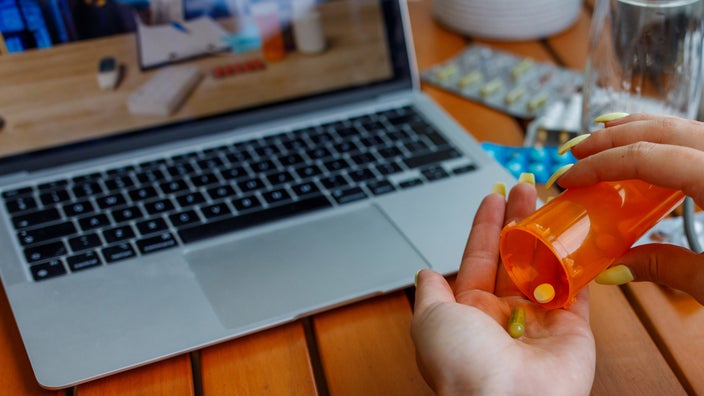
Prescription Quantity Limits: What to Do When Insurance Coverage Is Restricted
Key takeaways:
Prescription refill rules vary between insurance plans. Refill rules can also depend on the state or territory you’re in and the type of medication being filled.
Laws and policies regarding controlled substance prescriptions are much stricter than for non-controlled substances. These types of medications often can’t be refilled more than a couple days early.
An emergency prescription refill is when a pharmacist authorizes a one-time refill of a maintenance medication because a healthcare provider cannot be reached in a timely manner. The amount and type of medication that can be provided varies between states.

As with other forms of coverage restrictions, insurance plans use quantity limits to help ensure patient safety and control healthcare costs. Quantity limits define how much of a medication you can fill during a specific time period, but they can be a hassle. Insurance providers can also set prescription refill rules for medications. These rules require you to wait a certain amount of time between refills of a prescription.
But what happens if you lose a prescription? Or what if you’re out of refills and can’t get a hold of your healthcare provider for a new prescription? Well, you should know there are ways to obtain an emergency prescription refill in many cases. Let’s dive into how to navigate your plan’s policies, so you can still get the medications you need.
Prescription refill rules: quantity limits and refills too soon
Generally speaking, insurance plans will review clinical and FDA literature, as well as economic data, to decide how much of a medication they will cover in a certain time period. Different quantity limits apply to different medications. And quantity limits can change at any time. This means the amount your plan covers can change from one refill to the next. However, these changes are most commonly seen at the start of a plan’s coverage year.
SHINGRIX (Zoster Vaccine Recombinant, Adjuvanted) is now $0 for almost everyone*
Get SHINGRIX at the pharmacy or in-network doctor’s office today. 98% of privately insured people pay $0 and all Medicare Part D beneficiaries pay $0 at the pharmacy.
Prescribing Information
*Coverage and cost may vary and are subject to change without notice. Reimbursement decisions are made by individual insurance plans.


SHINGRIX is an FDA-approved vaccine for the prevention of shingles (herpes zoster) in adults 50 years and older. SHINGRIX is not used to prevent chickenpox.
• You should not receive SHINGRIX if you are allergic to any of its ingredients or had an allergic reaction to a previous dose of SHINGRIX
• An increased risk of Guillain-Barré syndrome (severe muscle weakness) was observed after vaccination with SHINGRIX
• Fainting can happen after getting injectable vaccines, including SHINGRIX. Precautions should be taken to avoid falling and injury due to fainting
• The most common side effects are pain, redness, and swelling at the injection site, muscle pain, tiredness, headache, shivering, fever, and upset stomach
• SHINGRIX was not studied in pregnant or nursing women. Tell your healthcare provider if you are pregnant, plan to become pregnant, or are breastfeeding
• Vaccination with SHINGRIX may not protect all individuals
• Ask your healthcare provider about the risks and benefits of SHINGRIX. Only a healthcare provider can decide if SHINGRIX is right for you
You are encouraged to report vaccine adverse events to the US Department of Health and Human Services. Visit www.vaers.hhs.gov to file a report, or call 1-800-822-7967.
For US audiences.
Trademarks are property of their respective owners.
©️2024 GSK or licensor.
PMUS-SGXWCNT240015 May 2024
Produced in the USA.
GoodRx Health information and resources are reviewed by our editorial staff with medical and healthcare policy and pricing experience. See our editorial policy for more detail. We also provide access to services offered by GoodRx and our partners when we think these services might be useful to our visitors. We may receive compensation when a user decides to leverage these services, but making them available does not influence the medical content our editorial staff provides.
Plans can implement a day-to-day quantity limit. For example, your plan may cover one tablet of atorvastatin (Lipitor) per day. So if you get a 30-day supply, you’ll only get 30 tablets. Plans can also work in month time frames. For example, an insurance plan may only cover 18 tablets of sumatriptan (Imitrex) every 30 days.
For some medications with serious side effects, like opioids, some plans, states, and pharmacies may only cover a few days’ worth for first-time prescriptions. For example, Colorado limits people to a 7-day supply of an opioid if they haven’t filled an opioid prescription from the same prescriber in the past year. These laws vary by location, so it’s best to ask your pharmacist for details regarding your state’s regulations.
When you’re out of your medication under a quantity limit and you need more, you may need to pay out-of-pocket (without insurance coverage). But this isn’t always an option. In some cases, you may be out of refills and need to ask your healthcare provider for a new prescription. And depending on the type of medication and the state you’re in, paying out-of-pocket for an early refill may not be allowed by law. This is typically the case for controlled substance medications.
If your insurer tells you it’s “too soon” to refill your prescription, your pharmacist or healthcare provider can often work with you to make sure you’re able to access your necessary medications.
How can I get an emergency prescription refill?
If for whatever reason you need an emergency prescription refill, there are ways that a pharmacist can help handle this. Reasons you might need an emergency refill include:
You lost your medication.
Your medication was stolen.
You need a backup supply of your medication.
A natural disaster, such as a flood, has destroyed or damaged your medication.
You forgot to pack your medication before leaving for a trip.
Your pharmacy has closed unexpectedly and you need to pick up your medication at a different pharmacy.
Read more like this
Explore these related articles, suggested for readers like you.
When you ask your pharmacist for an emergency refill, you might encounter what pharmacies and insurers refer to as a “refill too soon” restriction. These are enforced by insurance companies to make sure you’re taking your medication as directed, and not filling prescriptions too frequently.
When it comes to controlled substances, states and individual pharmacies also have restrictions regarding how often you can refill them. For example, many pharmacies don’t typically fill controlled substance prescriptions more than 2 days early; the specific number of days varies by pharmacy. This can help prevent misuse and abuse of medications, but still ensures a person receives their medication before they run out.
If you don’t have enough remaining refills, pharmacists can use their clinical judgment in accordance with state laws to dispense emergency refills. This emergency prescription refill law, known as Kevin’s Law, allows pharmacists to authorize an emergency fill of certain chronic medications if a healthcare provider cannot be reached to authorize a prescription.
Each state’s law may differ on:
The specific medications allowed
How much of the medication can be dispensed
How often you can get an emergency refill
If the medication will be covered by insurance
If the “refill too soon” roadblock means that your insurer is unwilling to provide coverage, GoodRx can help you navigate other ways to save. Savings opportunities include free GoodRx coupons, copay savings cards, and patient assistance programs. This is a good short-term solution if you need your emergency refill today and your insurer will not cover it.
How early can I get a prescription refilled?
The answer to this question varies depending on many factors. But common rules seen at many pharmacies are 7 days early for non-controlled substances, and 2 days early for controlled substances.
Insurance plans often require a certain amount of time to pass since your last fill. A common restriction for non-controlled prescriptions is that at least 75% of your previous refill must be used up. So if you have a 30-day prescription, you can get your refill on day 23 — or 7 days early.
Restrictions for controlled substances are often set by state laws or pharmacy policies, instead of insurance limits. It’s common to see a 2-day window for refilling these types of medications early. Some people even call it the “28 day prescription rule” for controlled substances they fill monthly. In other words, there needs to be at least 28 days between refills of 30-day prescriptions.
How can I get a quantity limit exception?
What if you need a certain amount of medicine and your plan doesn’t cover it? You may be able to apply for a quantity limit exception.
To request an exception, ask your healthcare provider to help you submit a quantity limit exception form. Your provider will need to give an explanation of your health condition and why the quantity limit would be harmful. You may also need to show that you’ve already tried lower doses of the medication or alternative treatments (called step therapy).
Many plans try to review requests within 3 days, after which, you’ll hear from your provider or pharmacist about whether you can fill your prescription. Your provider may also be able to request an expedited review in cases of health emergencies. This can sometimes shorten the review process to 24 hours.
What if my quantity limit exception request is denied?
If you’ve already tried to get a quantity limit exception and your request was denied, you can either try to appeal or seek other treatment options.
Appeals
With appeals, make sure you send in a written request on time. Plans will usually give you a set amount of time after the exception denial to send in the appeal. Then, they’ll make a decision within 30 days. If you’re in a health emergency, you and your healthcare provider can ask for an expedited appeal that may shorten the review time.
Alternative medications
If you’re still in a bind, ask your healthcare provider if there are alternative treatments you could try. Depending on the medication, some plans may cover another treatment in the same class of medications. For example, if you’ve reached your quantity limit for sildenafil (Viagra), your provider may suggest trying tadalafil (Cialis), since it works similarly. If they feel it’s an appropriate option for you, your provider would have to write you a new prescription for this alternative.
How to save
Unless your state or individual pharmacy has a quantity limit on the medication you need, you can bypass trying to get coverage altogether and pay for your medication out of pocket. Here are some tips to save:
Ask your healthcare provider to write you a 90-day prescription (instead of a 30-day one), which can often be cheaper in the long run.
Ask your healthcare provider if they have any free samples of the medication.
Check if the manufacturer of your medication has a savings card or patient assistance program. For more information about those programs, search for your medication on GoodRx and look for the “Ways to save” section towards the bottom of the page.
Shop around. GoodRx lists prices of medications at various pharmacies as well as coupons that have helped patients save as much as 80% or more off the price of their medication.
The bottom line
Prescription quantity limits set by insurance plans can be frustrating. But there may still be ways to get the medication you need if you’ve run out. Many plans allow you to fill non-controlled substance prescriptions several days early. Emergency prescription refills may also be an option if you’re out of refills and your healthcare provider is unavailable. You can explore requesting quantity limit exceptions with your healthcare provider, as well. Keep in mind there are ways to save without insurance too, including copay cards, patient assistance programs, and free GoodRx coupons.
Why trust our experts?


References
Academy of Managed Care Pharmacy. (2009). Formulary management.
Centers for Medicare & Medicaid Services. (n.d.). Drug plan coverage rules.
Opioid Response Network. (2021). Opioid regulations: State by state guide.





























